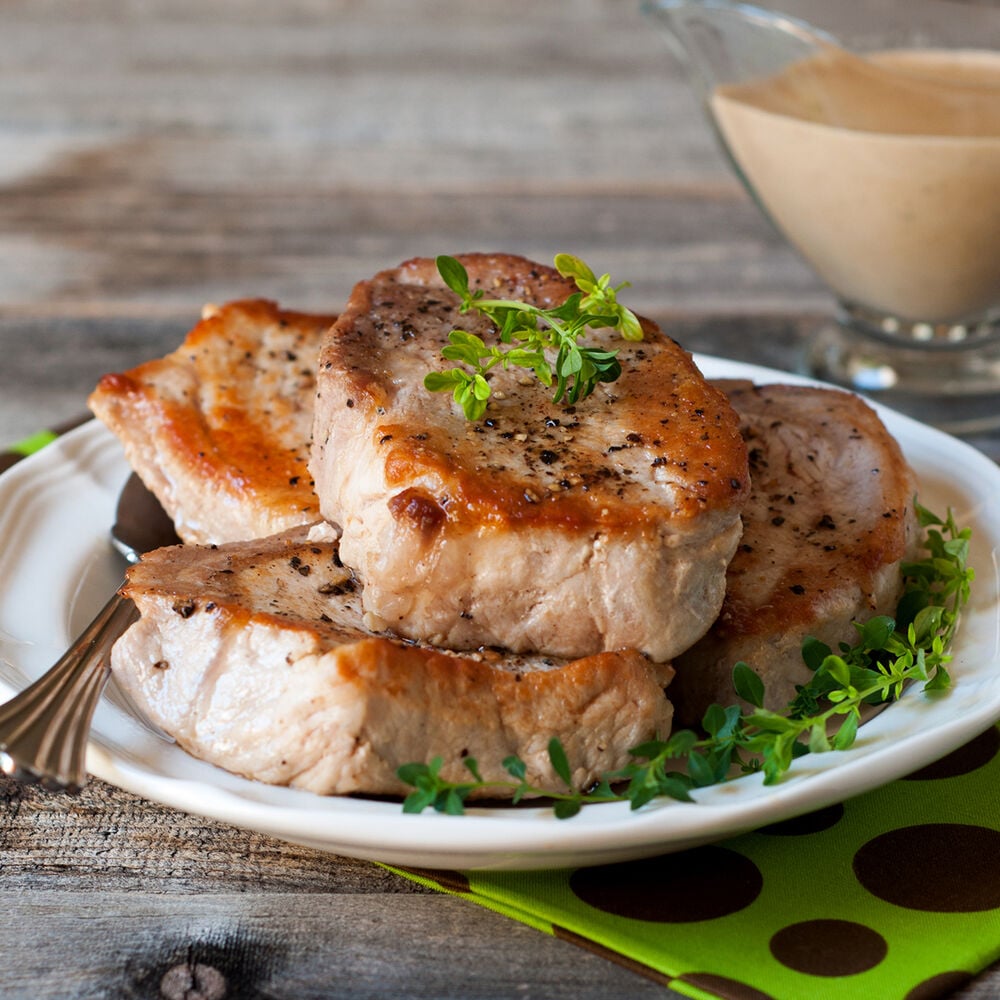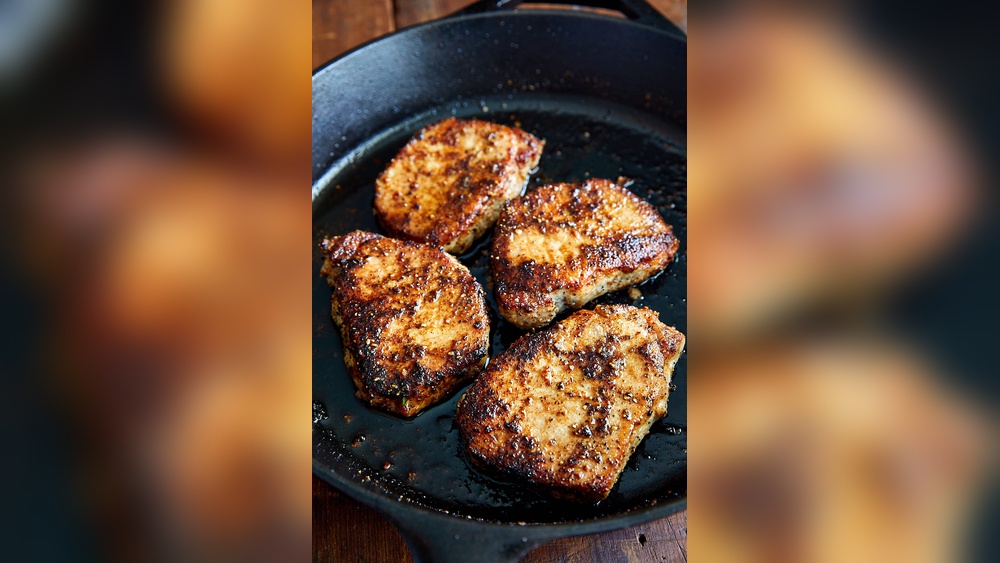If you want juicy, flavorful boneless pork chops cooked to perfection, using a cast iron skillet is one of the best ways to get there. You might have tried cooking pork chops before but ended up with dry or tough meat.
This guide will show you exactly how to cook boneless pork chops in a cast iron skillet so they stay tender and full of taste. By the end, you’ll have a simple, foolproof method to impress yourself and anyone you’re cooking for.
Ready to turn ordinary pork chops into a delicious meal? Let’s dive in!

Credit: www.wholesomeyum.com
Choosing The Right Pork Chops
Choosing the right pork chops is key to cooking juicy, tender meat in a cast iron skillet. The cut and quality influence taste and texture greatly. Picking the best pork chop makes cooking easier and more enjoyable.
Selecting Boneless Cuts
Boneless pork chops are easy to cook and quick to eat. They come from the loin, which is a lean part of the pig. Choose chops that look fresh and pink, not dull or gray. Avoid any with a lot of liquid in the package.
Look for chops with a little fat around the edge. This fat keeps the meat moist during cooking. Avoid very thin cuts that dry out fast. Boneless chops give you a good balance of flavor and tenderness.
Thickness And Quality Tips
Pick pork chops at least one inch thick. Thicker chops cook evenly and stay juicy inside. Thin chops can cook too fast and become tough. Thicker chops also give you a nice crust on the outside.
Check for marbling, the small streaks of fat in the meat. Marbling adds flavor and keeps chops tender. Choose meat with a fine, even texture. Avoid chops with bruises or dark spots.
Freshness matters. Always buy from a trusted source. Fresh pork chops have a mild smell and firm texture. This ensures the best taste and safety for your meal.

Credit: www.perduefarms.com
Preparing The Pork Chops
Preparing boneless pork chops correctly sets the stage for a juicy and tasty meal. Taking a few simple steps before cooking can improve texture and flavor. These steps ensure the pork cooks evenly and tastes its best.
Trimming And Patting Dry
Start by trimming any extra fat or silver skin from the pork chops. Removing these parts helps the meat cook evenly and avoids chewy bits. Next, use paper towels to pat the chops dry. Drying the surface helps achieve a nice, crispy crust when seared in the skillet.
Seasoning Techniques
Seasoning is key to enhancing the natural flavor of pork chops. Sprinkle salt and pepper evenly on both sides. For more flavor, add garlic powder, paprika, or your favorite herbs. Press the seasoning gently into the meat to help it stick. Let the chops rest for a few minutes to absorb the spices before cooking.
Setting Up The Cast Iron Skillet
Setting up your cast iron skillet properly is key to cooking juicy boneless pork chops. The right preparation helps the meat cook evenly and prevents sticking. It also creates a nice crust on the outside.
Before cooking, focus on heating the pan and choosing the best oil. These steps improve flavor and texture. A well-prepared skillet makes the cooking process easier and more enjoyable.
Preheating Tips
Preheat the skillet over medium heat for about 5 minutes. The pan should feel hot but not smoking. Test heat by sprinkling a few drops of water. If they sizzle and evaporate quickly, the pan is ready.
Even heat distribution is important. It helps cook pork chops evenly and avoids burning. Avoid overheating, which can damage the seasoning on your skillet.
Using The Right Oil
Choose an oil with a high smoke point. Canola, vegetable, or avocado oil works well. These oils handle heat without burning quickly.
Pour just enough oil to coat the skillet’s surface. Too much oil can cause splatter and make the pork chops greasy. Spread it evenly before adding the meat.
Cooking Process
Cooking boneless pork chops in a cast iron skillet is simple and quick. The process ensures juicy, flavorful meat with a nice crust. Follow these steps carefully to get the best results.
Searing The Pork Chops
Start by heating the cast iron skillet over medium-high heat. Add a small amount of oil to prevent sticking. Place the pork chops in the hot skillet without crowding. Let them cook undisturbed for 3 to 4 minutes. This step creates a golden-brown crust that locks in juices.
Adjusting Heat For Even Cooking
After searing, lower the heat to medium or medium-low. This adjustment helps cook the pork chops evenly inside. Too high heat can burn the outside while leaving the inside raw. Keep the skillet at a steady temperature to avoid uneven cooking.
Flipping At The Right Time
Flip the pork chops once the first side is golden and releases easily. Use tongs to turn them gently. Cook the second side for another 3 to 4 minutes. Avoid flipping multiple times. One flip ensures a well-cooked, tender chop.
Checking For Doneness
Checking for doneness is key when cooking boneless pork chops in a cast iron skillet. It ensures the meat is safe and juicy. Overcooked pork becomes dry and tough. Undercooked pork can be unsafe to eat. Use simple methods to check if your pork chops are ready to serve.
Using A Meat Thermometer
A meat thermometer is the most accurate way to check doneness. Insert it into the thickest part of the pork chop. The safe internal temperature for pork is 145°F (63°C). Once it reaches this, remove the chops from the skillet. Let the meat rest for a few minutes. Resting helps the juices spread evenly inside.
Visual And Texture Cues
Visual signs help you guess doneness without tools. The pork chop’s color should be light pink or white inside. The juices running out must be clear, not red or pink. Press the chop with your finger. It should feel firm but still spring back slightly. Soft and squishy means undercooked. Very hard means overcooked.
Resting And Serving
Resting and serving boneless pork chops cooked in a cast iron skillet is a key step. It helps keep the meat juicy and tender. Skipping this step causes the juices to escape, making the pork dry. Proper resting also lets the flavors settle inside the meat.
Allowing Juices To Settle
After cooking, place the pork chops on a warm plate. Let them rest for 5 to 10 minutes. Cover loosely with foil to keep heat in. Resting allows the juices to spread evenly inside the meat. This makes each bite moist and flavorful. Cutting too soon lets the juices run out on the plate.
Serving Suggestions
Serve the rested pork chops with simple sides. Mashed potatoes and steamed vegetables work well. A fresh salad adds a nice crunch. Spoon pan juices or a light sauce over the chops. This adds more taste and moisture. Keep the presentation clean and inviting. Enjoy a satisfying meal with minimal effort.
Tips For Extra Juiciness
Keeping boneless pork chops juicy while cooking in a cast iron skillet can be tricky. Dry chops lose their flavor and texture quickly. These tips help keep the meat tender and full of moisture. Simple steps make a big difference in the final dish.
Try these methods to lock in juices and enjoy a better meal every time.
Brining Options
Brining adds moisture to pork chops before cooking. Soaking the meat in a saltwater solution helps the cells hold water. This makes the chops juicy after cooking. Use a simple mix of water, salt, and sugar. Let the pork soak for 30 minutes to 2 hours. Avoid over-brining to prevent a salty taste. You can add herbs or garlic to the brine for extra flavor.
Butter Basting Technique
Butter basting keeps pork chops moist during cooking. Start by searing the chops in the skillet. Then add butter, garlic, and herbs to the pan. Tilt the skillet and spoon the melted butter over the meat. This adds flavor and moisture. Baste often for even cooking and a juicy result. Finish cooking on medium heat to avoid drying out the chops.

Credit: www.seccsidcup.org.uk
Common Mistakes To Avoid
Cooking boneless pork chops in a cast iron skillet is simple. Yet, some common mistakes can ruin the dish. Avoiding these errors helps you get juicy, flavorful chops every time. Below are key mistakes to watch out for.
Overcooking Issues
Overcooking pork chops makes them dry and tough. Cast iron retains heat well, so chops can cook fast. Check the internal temperature with a meat thermometer. Aim for 145°F (63°C) for safe, juicy pork. Remove the chops from the skillet just before they reach this temperature. Rest them for a few minutes to finish cooking. Avoid cooking on too high heat. It burns the outside before the inside cooks.
Skillet Maintenance
Dirty or poorly maintained skillets cause food to stick. Clean the skillet properly after each use. Avoid using soap, which strips the seasoning. Use hot water and a stiff brush instead. Dry the skillet completely to stop rust. Apply a thin layer of oil before storing. Well-seasoned skillets create a natural non-stick surface. This helps cook pork chops evenly and prevents sticking.
Frequently Asked Questions
How Long To Cook Boneless Pork Chops In Cast Iron?
Cook boneless pork chops 4-5 minutes per side over medium-high heat. Ensure internal temperature reaches 145°F for safety and juiciness.
Should You Marinate Pork Chops Before Cooking?
Marinating enhances flavor and tenderness. A 30-minute to 2-hour marinade works best before cooking in a cast iron skillet.
How To Prevent Pork Chops From Sticking To Cast Iron?
Preheat the skillet well and add oil before cooking. Avoid moving chops too soon to prevent sticking.
What Oil Is Best For Cooking Pork Chops?
Use oils with high smoke points like avocado, canola, or vegetable oil for best results in cast iron cooking.
Conclusion
Cooking boneless pork chops in a cast iron skillet is simple and quick. You get a juicy, flavorful meal every time. Just follow the steps carefully and watch the heat. Use the right seasoning to add taste. Enjoy a delicious dinner with little effort.
Try this method to cook pork chops often. It makes cooking fun and easy. Give it a go and see the difference yourself. Cooking at home can be tasty and satisfying. Boneless pork chops in a skillet? Yes, you can!

